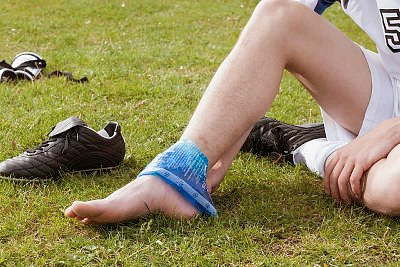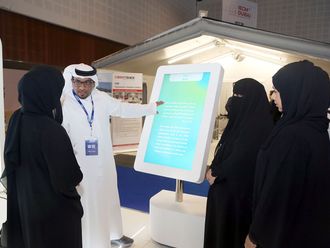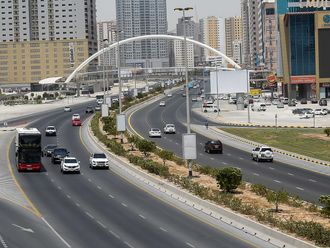
The UAE is increasingly becoming a sports lover’s haven with over 100km of cycle tracks, football fields, beaches, and indoor sports centres and stadiums. However, sports-related injuries are also on the rise. GN Focus talks to three specialists in sports science about the most common injuries, how to treat them, and prevention tactics.
Ankle (sprains)
Ankle sprains are a common injury in sports such as football, rugby and tennis. They generally occur when the ankle is twisted around its longitudinal axis, or bent to one of the sides. Ankle sprains are extremely painful but the prognosis can be good if treated properly.
Treatment
“Ankle sprains can be difficult to rehabilitate if not managed correctly, so make sure you seek advice from a reputable sports medicine doctor or physiotherapist,” says Wilkinson. As ankle sprains are often caused by walking or playing sport on uneven ground (sand) and wearing unsupportive shoes (such as flip flops), ensuring good ankle stability is the best cure. If you feel you have weak ankles, exercises prescribed by a trained physiotherapist can help speed up a recovery.
Shoulder (Rotator cuff/shoulder tendonitis or bursitis)
Dr Chris Whately, Orthopaedic Specialist and Medical Director of Medcare Orthopaedics and Spine Hospital, says these common injuries start with pain in the deltoid muscle area. Shoulder injuries may be caused by activities such as throwing, swimming and weightlifting, or after a hard fall. There may be a tear of the tendon in the shoulder with associated swelling and inflammation. Training adaptions and poor posture are also possible causes, says Hannah Wilkinson, Sports Physiotherapist, Up and Running Integrated Sports Medical Center.
Treatment
“Physiotherapy to maintain range of motion and strengthen the rotator cuff, anti-inflammatory medication, and time,” says Dr Whately. “If symptoms don’t settle after several weeks or months, we offer cortisone injections, and occasionally surgery.” Wilkinson recommends seeking ergonomic advice on seated posture.
Lower back (strains, herniated discs)
One of the most common injuries in the UAE, lower back pain and sciatica (pain shooting down the leg from the back) can occur in athletes and non-athletes alike. “There may be a known cause such as lifting a heavy object, a simple twist or a fall during sports but often there is no known cause at all,” said Dr Whately. “However”, Wilkinson continued, “back pain can stem from poor posture, repetitive strain, poor mechanics, or muscle weakness caused by a sedentary lifestyle.”
Treatment
Dr Whately says the first step is to wait until the pain goes away, do back exercises and take anti-inflammatory tablets. If this fails, seek specialist help. In more severe cases, injections can help and rarely, especially if nerves are involved, surgery may be required. Wilkinson says, “Some ways to lower the risk of back pain are to walk regally and strengthening exercises such as Pilates and swimming.”
Knee (meniscus tears and ACL tears or ruptures)
Dr Jose Couceiro, Consultant Orthopaedic Surgeon at Exeter Medical Centre for Bone and Joint Health (Dubai branch), explains that a twisting motion around the knee causes the meniscus, a small cushion block around the inside of the knee, to rupture, causing pain and knee instability. “It can even result in difficulty walking due to severe swelling,” says Wilkinson. Dr Whately says, “Inside the knee, the meniscus are two semicircular pieces of cartilage — one on the inner surface of the knee joint [medial meniscus] and one on the outer surface [lateral meniscus]. The anterior cruciate ligament [ACL] is a strong, thick band from the back of the femur to the front of the tibia that [can be damaged by] a high-energy twist and fall or a bad tackle. The active lifestyle in the UAE often brings high-level athletes and weekend warriors to our clinics with these injuries. These usually [happen] while running, and especially high-impact sports such as football, rugby, basketball, ice hockey and skiing.”
Treatment
Dr Whately usually recommends rest, ice, compression and elevation, alongside physiotherapy and anti-inflammatory medication for acute injuries. “Some of these tears don’t heal and [need] surgical treatment with arthroscopy. Surgery usually involves cutting out the torn fragment. High-level athletes and people who feel their knee is giving out often have surgery for their ACL. This is done through very small surgical incisions using other tendons such as the hamstrings to reconstruct the ACL.” Wilkinson says activities such as foam rolling and pre-exercise stretching/warm-ups can help prevent these injuries.
Elbow (Tennis elbow)
According to Dr Couceiro, repetitive motion, as seen with tennis and other similar sports, can cause swelling of the tendons around the elbow — a condition commonly known as tennis elbow (lateral epicondylitis). This results in elbow and wrist pain when performing daily activities or sports that require vigorous use of the arm. “Tennis elbow tends to be very frustrating for both patients and their doctors as there is no guaranteed cure,” explains Dr Whately. “Avoiding activities that can aggravate it can help, which may, unfortunately, mean changing your sport.”
Treatment
“Physiotherapy, tennis elbow straps, anti-inflammatories, ultrasound and steroid injections can help with tennis elbow,” says Dr Whately, “while surgery is indicated on rare occasions.”
Calf (Gastrocnemius muscle tears)
A calf strain is a tear in the calf muscle commonly associated with pain in the back of the lower leg. “This results from walking, running, jumping, and movement that requires quick changes of direction, which frequently occurs when exercising on UAE beaches,” Wilkinson explains. Dr Couceiro says, “Often an acute push off the foot produces an injury to the muscles in the calf. This leads to immediate pain and sometimes a transient inability to walk.”
Treatment
Specialist rehabilitation advice can allow a fast return to your sport and minimal long-term effects. “When mismanaged, gastric strain can become chronic and affect sporting and walking ability. Sensible footwear and adequate warm-ups such as foam rolling and dynamic stretching are preventative measures,” says Wilkinson.
***
The injuries mentioned can happen to anyone, Dr Whately explains. Prevention occurs primarily by starting slowly and building up your training programme as well as stretching before exercise. “It is very important to maintain an ideal weight and to strengthen the muscles for your sport. People who are more active have less pain and less disability than couch potatoes,” he adds. “If you do have an injury that does not settle down, see a specialist who can do a full history and examination along with the appropriate X-rays, MRIs and blood tests. This should get you a clear diagnosis and help you on the road to recovery.”












